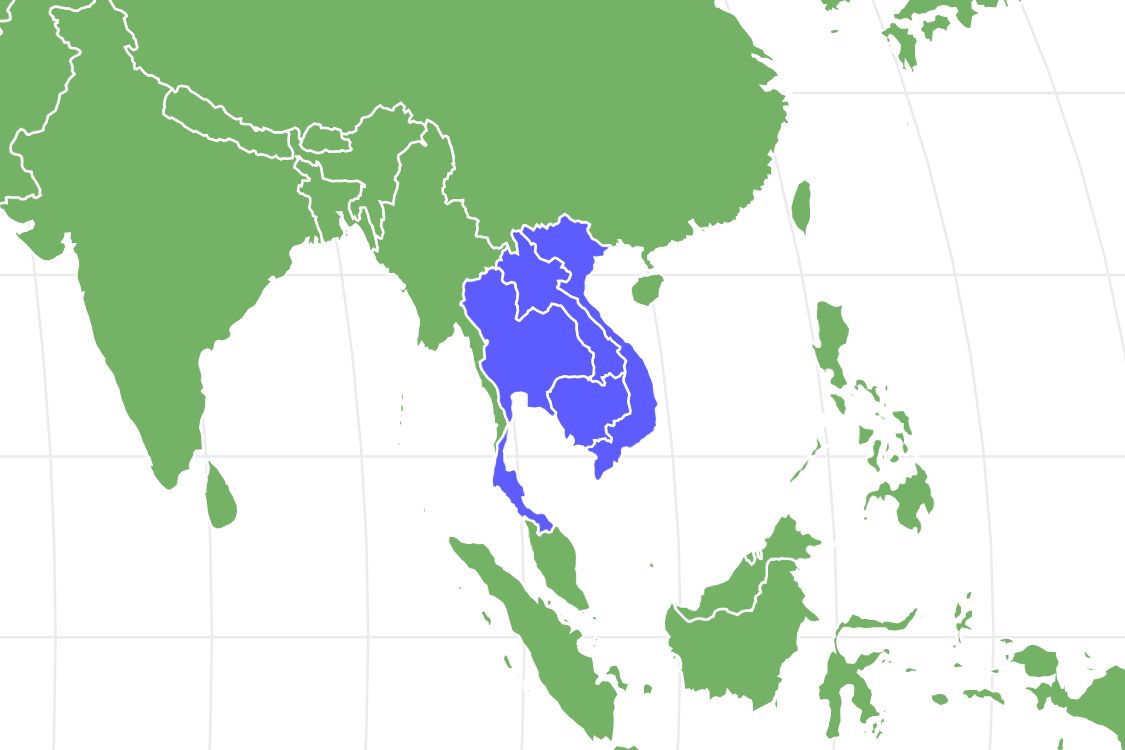Kouprey
Bos sauveli
The kouprey is one of the rarest mammals in the world
Advertisement
Kouprey Scientific Classification
- Kingdom
- Animalia
- Phylum
- Chordata
- Class
- Mammalia
- Order
- Artiodactyla
- Family
- Bovidae
- Genus
- Bovinae
- Scientific Name
- Bos sauveli
Read our Complete Guide to Classification of Animals.
Kouprey Conservation Status
Kouprey Facts
- Name Of Young
- Calves
- Group Behavior
- Solitary/Herd
- Fun Fact
- The kouprey is one of the rarest mammals in the world
- Estimated Population Size
- 100 to 300
- Biggest Threat
- Humans
- Most Distinctive Feature
- Dorsal hump
- Distinctive Feature
- Fluff on the end of their tail, white at the base of their legs, and frayed horns
- Other Name(s)
- Cambodian ox or wild forest ox
- Gestation Period
- 8 to 9 months
- Litter Size
- 1 calf
- Habitat
- Forests, savannas, and open lands
- Diet
- Herbivore
- Lifestyle
- Diurnal
- Favorite Food
- Grass
- Type
- Ox
- Common Name
- Kouprey
- Origin
- Cambodia
- Number Of Species
- 1
- Location
- Thailand, Vietnam, Cambodia, and Loas
View all of the Kouprey images!
The kouprey (also known as the Cambodian forest ox or wild forest ox) is a type of ox that is native to Southeast Asia. They are the national animal of Cambodia and mainly dwell in a forest environment. The kouprey is considered to be one of the rarest animals on the planet, and at one point they were even believed to be extinct.
There has not been many sighting of the kouprey since their discovery in 1937, but recent camera footage has shown that there are still kouprey roaming around, with parts of them being sold illegally.
As a type of ox, the kouprey is an interesting animal that many of you might not have known existed, which we will discuss in this article.
3 Quick Facts
- Koupreys are born with a reddish color, but they develop a brownish-gray color at around 5 to 6 months of age.
- Only a small population of kouprey still live in their native habitat in Eastern Cambodia, with an estimation of 50 still roaming around.
- Kouprey is considered to be one of the rarest animals on the planet, and one that humans hardly ever encounter.
Scientific Name
The kouprey’s scientific name is Bos sauveli, and they belong to the Bovidae family in the Bos genus from the order Artiodactyla.
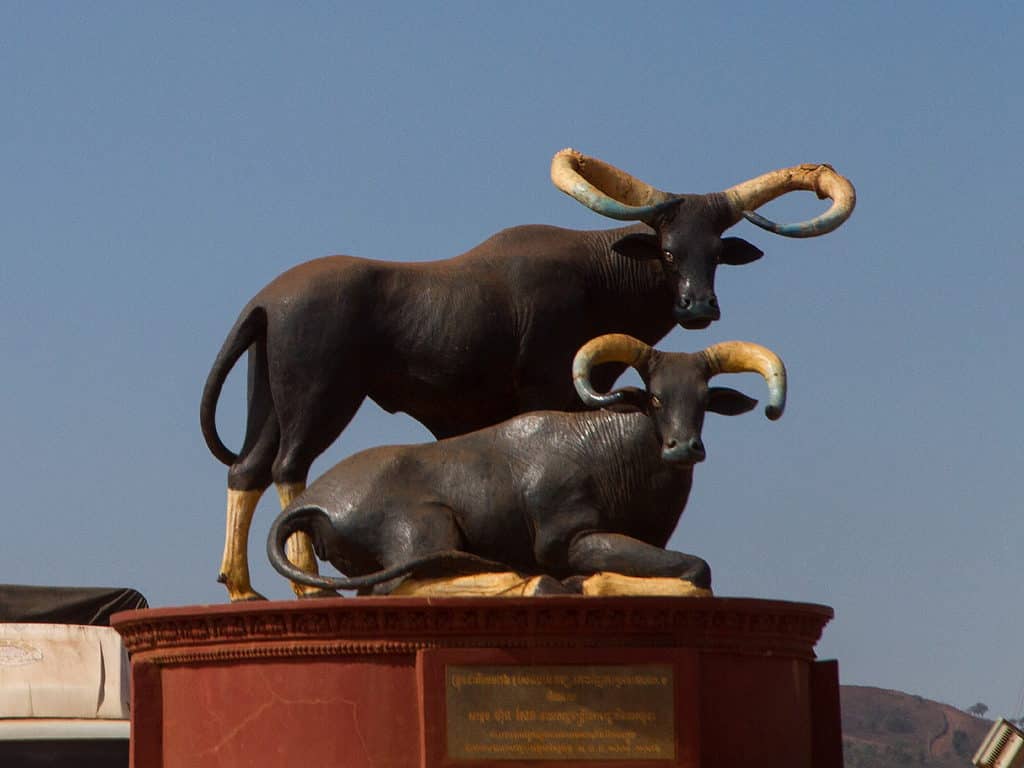
The kouprey is the national animal of Cambodia.
©Christian Pirkl, CC BY-SA 4.0 <https://creativecommons.org/licenses/by-sa/4.0>, via Wikimedia Commons – License
Kouprey Appearance
The kouprey is a moderately sized animal, reaching around 6.9 to 7.5 feet in length with a height of 5.6 to 6.2 feet, weighing anywhere between 1,500 to 2,100 pounds. Females tend to be smaller and weigh less than males, with a lighter coloration. Even though kouprey are heavy animals, they can still run quite fast at around 32 kilometers per hour.
Kouprey have a defined dorsal hump on their backs and a long, narrow tail that reaches a length of 3.3 feet and ends with a furry patch. Both male and female kouprey have horns. The horns of the kouprey are the same size in both males and females, at around 32 inches in length. The female kouprey horns have a lyre shape, while the males are more intimidating and arch forward with a curved base.
The kouprey nostrils are notched and they have an elongated face. Their legs are long, with a whitish-grey color past their knees that look like stockings.
You can see kouprey in colors that range from grey, dark brown, and even black, but they all start off with a reddish color as a baby and juvenile before they turn 6 months old and begin to change color. One of the most distinctive features of this species is that their horns become frayed, especially in older males (bulls).
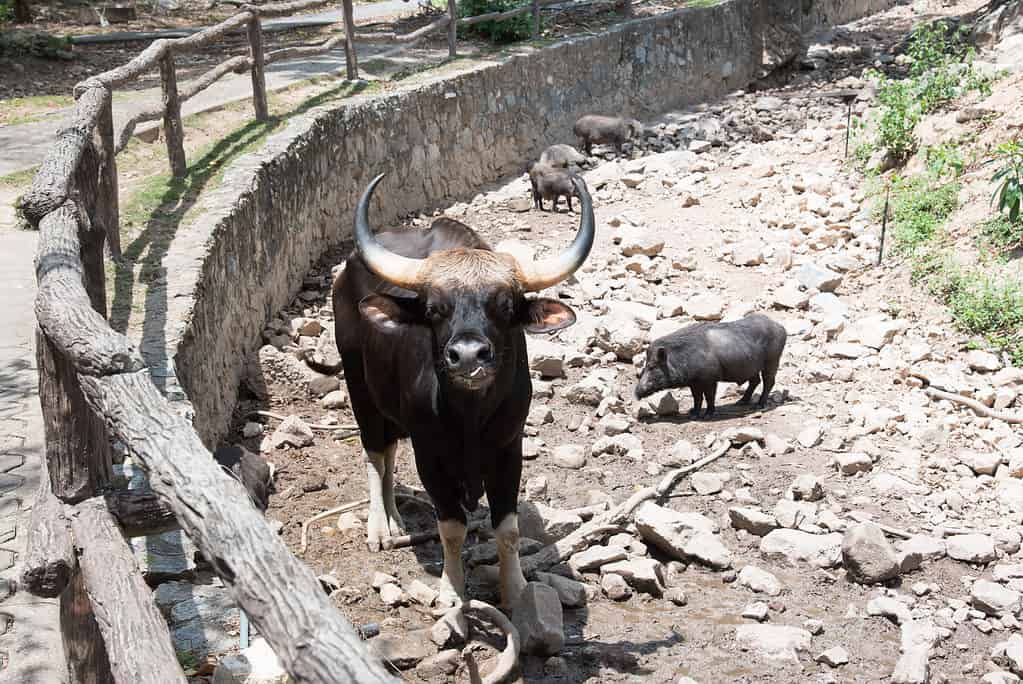
Kouprey (
Bos sauveli) have notched nostrils, an elongated face and their legs are long, with a whitish-grey color past their knees like stockings.
©Prachaya Teerakathiti/Shutterstock.com
Kouprey Evolution and History
The kouprey was first described in 1937 by the French zoologist, Achille Urbain after a young male kouprey was sent to the Paris Zoological Park. Urbain then described the kouprey as a holotype.
At the time of the koupreys discovery, there were believed to be no more than 2,000 in the wild, which was in Thailand, northern Cambodia, western Vietnam, and the southern part of Laos. Kouprey is native to Cambodia, but now there are only a few left in the wild, making them rare.
Throughout history, there have only been a few sightings of the kouprey, but no verified sightings occurred between 1969 and 1970, making scientists believe that they went extinct from their natural habitat. It was thought that only 100 koupreys were still in the wild, but some believe there to be up to 300. Regardless, this is still a small amount of kouprey in the wild.
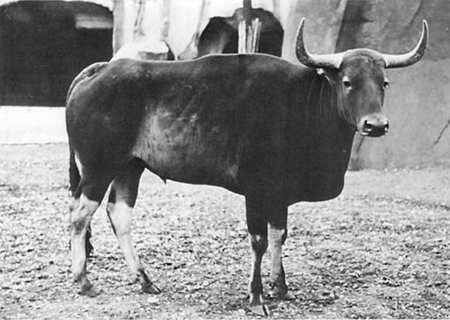
The kouprey population is very low, making them critically endangered and vulnerable to extinction.
©vivtony00 / Flickr – License
Kouprey Behavior
There are many interesting behaviors that have been discovered in a kouprey herd. The herd usually consists of around 20 koupreys that group together, with one female being dominant and leading the herd. As the kouprey bulls get older, they usually become solitary and leave the herd.
Some bulls even start up a small all-males herd, while the rest of the herd consists of young bulls, females (cows), and their calves. In some cases, when all the males leave the herd, only the cows and their calves will remain and form their own small herd. Sometimes, the all-male herd and the rest of the herd join together when they encounter one another again.
Koupreys are diurnal animals, that prefer to stay out in the open at night and take shelter in their forestry homes during the day. This diurnal behavior could be another reason that humans rarely see these animals. Kouprey can travel up to 15 kilometers a night in search of food and shelter, which is how the herds will cross paths and end up with each other again.
Kouprey will also take a dip in mud baths and waterholes, which help repel insects and protect them from the harsh sun.
Kouprey Habitat
- Open forests
- Orchard savannas
- Barren land with trees
- Monsoon forests
The kouprey’s habitat consists of dry, open forests, with thick trees that they spend the day hiding under. However, when it gets hot, they will move to a denser forest that has better shade. Kouprey will also inhabit orchard savannas and barren land with trees, usually on low hills or plains. During the rainy seasons, herds by the lower plains will start to move towards the hills in search of higher ground, usually because of any flooding that occurs.
They are distributed throughout Cambodia, their land of origin, to Laos, Thailand, and Vietnam. Kouprey is also distributed in wildlife sanctuaries, which are crucial for the species’ survival since not many can be found in the wild.
The numbers and sightings of the kouprey are so low, that they are believed to be extinct in eastern Cambodia, aside from being found in the Mondulkiri Protected Forest.
So far, kouprey can be found in the Phnom Prich Wildlife Sanctuary, the Lomphat Wildlife Sanctuary, and the Keo Seima Wildlife Sanctuary.
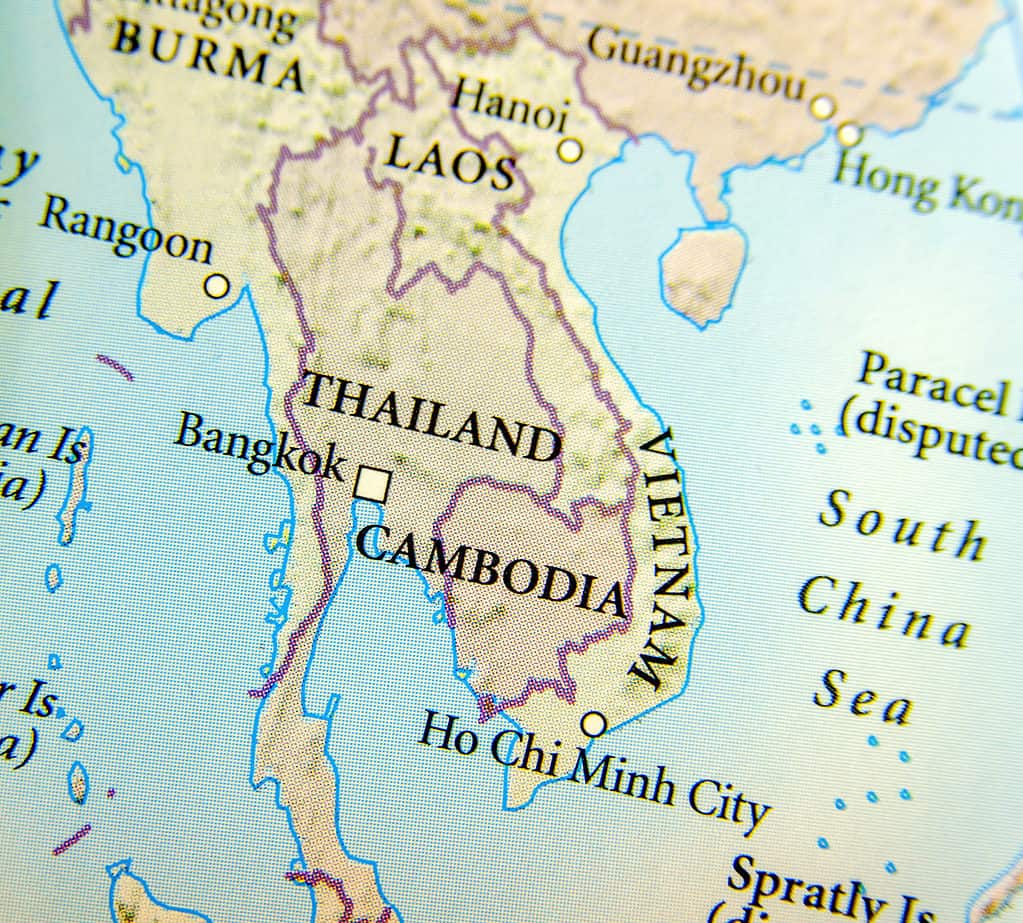
Kouprey are distributed throughout their land of origin Cambodia, Laos, Thailand, and Vietnam as well as wildlife sanctuaries.
©Bennian/Shutterstock.com
Kouprey Diet
Koupreys are herbivores that spend most of their time grazing. They eat a variety of grasses which forms the main part of their diet, along with plant shoots such as koompassia, ploong, and bamboo. They will also consume sedges, and in the sanctuaries, they will enjoy salt licks as part of their diet.
Kouprey Predators and Threats
The main threat and predator to kouprey are humans, who use the animal for their horns and body parts to be sold illegally on the black market. Habitat destruction from logging and agricultural developments due to humans is another reason for their low numbers in the wild.
Another threat that the kouprey face is from hunters, who then use parts of the kouprey for medicine, bush meat, subsistence, and money from trading. Parts of the kouprey sell for a lot of money on this illegal market, making them a desirable trophy, the skulls, and horns of the kouprey are also a target of the illegal wildlife trade, contributing to the kouprey extinction.
Kouprey Reproduction and Life Span
Groups of mature bulls will seek out any of the female koupreys in heat (estrus), even if they have formed their own male-dominated herd. The male will then pursue the female until she is willing to mate.
Once mating occurs, the female has a gestation period between 8 to 9 months, much like a human, and she will separate herself from the herd to give birth. Once the calf is born and around one month old, the female kouprey will then rejoin her original herd. The calves will have a red coloration, that changes as they get older to adult color.
Kouprey lives for up to 20 years, similar to that of an ox, cow, and many other bovine animals.
Kouprey Population
The kouprey population is very low, making them critically endangered and vulnerable to extinction according to the IUCN red list. They are also the most endangered mammal on the planet.
There is now an estimation of 100 to 300 kouprey left in the wild, with speculation on whether they have gone extinct in their native habitat. This makes conservation important for the kouprey, and if we don’t do something soon, this animal can go extinct.
Related Animals
View all 77 animals that start with KKouprey FAQs (Frequently Asked Questions)
Where are kouprey found?
Kouprey are native to Cambodia, and they can be found in Thailand, Vietnam, and Loas. They inhabit open forests, savannas, and barren lands with trees.
What do kouprey eat?
The kouprey is an herbivore, that primarily eats grass and plant shoots in their diet.
Are kouprey extinct?
The kouprey is soon to be extinct due to humans, but there are still a small group of kouprey left in the world, making them one of the rarest and most endangered mammals in the world.
Thank you for reading! Have some feedback for us? Contact the AZ Animals editorial team.
Sources
- Britannica , Available here: https://www.britannica.com/animal/Hereford-breed-of-cattle
- Endangered wildlife organization , Available here: https://www.endangeredwildlife.org/wildlife/kouprey/#threats
- Academia , Available here: https://www.academia.edu/496115/Resolving_a_Zoological_Mystery_the_Kouprey_is_a_Real_Species
- WWF Panda , Available here: https://wwf.panda.org/discover/our_focus/wildlife_practice/profiles/mammals/kouprey/
- IUCN, Available here: https://www.iucnredlist.org/species/2890/46363360

